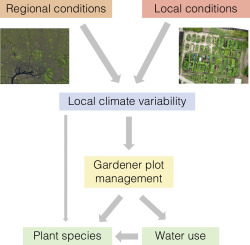Science of the Total Environment ( IF 8.2 ) Pub Date : 2018-07-20 , DOI: 10.1016/j.scitotenv.2018.07.270 Monika H. Egerer , Brenda B. Lin , Caragh G. Threlfall , Dave Kendal

|
Urban environments are being subject to increasing temperatures due to the combined effects of global climate change and urban heat. These increased temperatures, coupled with human planting preferences and green space management practices, influence how urban plants grow and survive. Urban community gardens are an increasingly popular land use, and a green space type that is influenced by unique climate-human behavior interactions. Despite ongoing rapid temperature changes in cities, it is unknown how gardeners are adapting to these changes, and to what extent changes influence planting decisions and patterns of urban plant diversity. In this study, we monitored the variation in daily air temperatures and measured plant species richness at the garden and garden plot scale in 11 community gardens in Melbourne, Australia. We surveyed >180 gardeners to better understand the relationships between temperature variation, garden plant species diversity, and gardener management practices. We found that garden scale temperature variability is driven by regional context, and temperatures are more stable in landscapes with higher impervious surface cover. Gardeners agreed that climatic/temperature changes are influencing their watering behavior, but not their plant selection. Instead plant selection is being driven by desired food production. Yet, when comparing two bioregions, temperature did have a measurable relationship with garden plant composition in the region with more temperature variation. Temperature variability negatively related to plant species richness within garden plots, providing evidence that plant survival is related to climate at this scale in such regions. Although gardeners may be able to water more in response to regional climate changes, gardeners are unlikely to be able to completely control the effects of temperature on plant survival in more variable conditions. This suggests the inner city with more stable temperatures (albeit potentially hotter for longer due to heat island) may accommodate more species diverse gardens.
中文翻译:

温度的变化会影响城市园林植物的丰富度和园丁的用水行为,但不会影响种植决策
由于全球气候变化和城市供热的共同作用,城市环境温度不断升高。这些升高的温度,再加上人类对植物的喜好和绿色空间管理做法,都会影响城市植物的生长和生存方式。城市社区花园是一种越来越受欢迎的土地利用方式,并且是一种受独特的气候-人类行为相互作用影响的绿色空间类型。尽管城市中温度持续快速变化,但尚不清楚园丁如何适应这些变化,以及变化在多大程度上影响种植决策和城市植物多样性的格局。在这项研究中,我们在澳大利亚墨尔本的11个社区花园中,监视了每日气温的变化并在花园和花园地块范围内测量了植物物种的丰富度。我们调查了> 180位园丁,以更好地了解温度变化,园林植物物种多样性和园丁管理实践之间的关系。我们发现,花园尺度的温度变异性受区域环境的影响,并且在具有较高的不透水地表的景观中,温度更为稳定。园丁们同意,气候/温度的变化会影响他们的浇水行为,但不会影响他们的植物选择。取而代之的是,植物的选择是由所需的粮食生产驱动的。然而,当比较两个生物区域时,温度确实与温度变化更大的区域中的园林植物组成具有可测量的关系。温度变化与花园地块内植物物种的丰富程度负相关,提供了证据表明植物存活率与此类地区的气候有关。尽管园丁可能能够响应区域气候变化而增加浇水,但园丁不太可能完全控制温度在更多可变条件下对植物存活的影响。这表明温度更稳定的内城(尽管由于热岛而可能变得更热)可能会容纳更多种类多样的花园。











































 京公网安备 11010802027423号
京公网安备 11010802027423号